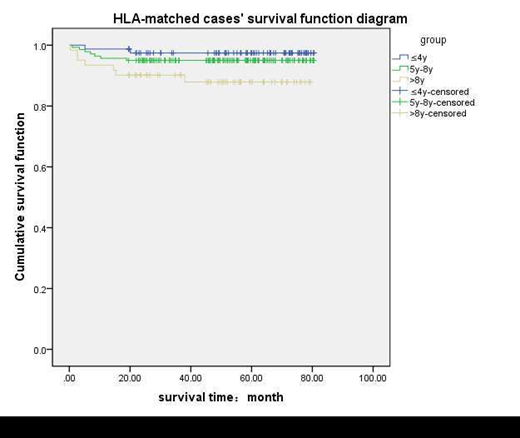Background/Objective:Adolescents are considered to be a high-risk group by pediatricians, and have long been regarded as high-risk patients by adult hematologists. Foreign related studies show that the degree of damage to the organ in older children after hematopoietic stem cell transplantation (HSCT) is more serious and late complications are more common in them. Considering this finding, we conducted an analysis on the age, the survival rate and complications among children who had had β-thalassemia major and received HSCT.
Methods:Among the children who had β-thalassemia major and were treated with HSCT in the Pediatrics Department of the Nanfang Hospital of Southern Medical University, we collected the data of 332 valid β-thalassemia children patients from January 1st, 2012 to June 30th, 2018 and following up the cases until September 30th, 2018. 281 β-thalassemia patients received allo-HSCT from HLA-matched sibling or unrelated donor and 51 β-thalassemia children patients received haplo-identical family donor. Based on the age of the children patients, the case data was divided into three groups for discussion and comparison: group 1 for ≤4 years, group 2 for 5 to 8 years and group 3 for over 8 years. For the three age groups, the correlation between the age and the incidence of GVHD, grade I & II, III and IV aGVHD, cGVHD and some complications such as infection, septicemia, convulsion, EVB infection, etc, was analyzed. Furthermore, the survival curves of the OS and the ESF of all age groups were compared.
Results:In 281 HLA-matched cases, OS and ESF after transplantation was 94.3% and 93.2% respectively and deaths in 16 cases(figure1). OS of group 1, 2 and 3 is 97.5%, 95% and 88.5%, respectively. OS of group 3 compared with group 1 is statistically significant with P-value =0.028 (P<0.05) and with group 2 is P=0.096(Kaplan-Meier estimator). EFS of group 1, 2 and 3 are 96.2%, 95% and 85.2%, respectively. EFS of group 3 compared with group 1 is P=0.020 (P<0.05) and with group 2 is P=0.018 (P<0.05)(Kaplan-Meier estimator). The age correlated with the incidence of GVHD, chronic GVHD, grade I & II acute graft-versus-host disease (Kaplan-Meier estimator), convulsion, oral infection and EVB infection (P < 0.05, χ2 test). In particular, the incidence was significantly higher in children above age 8 years as compared to the children under 8 years.
In 51 haploidentical family donor cases, OS and ESF after transplantation were 94.1% and 90.2% respectively, the total deaths in 3 cases, the incidence of grade I & II acute GVHD and EVB infection correlated with the age(P<0.05, χ2 test).
Conclusions:For HSCT of thalassemia, in HLA-matched cases, OS and ESF rates were lower in children above 8 years than the children below 8 years. In terms of GVHD, cGVHD, aGVHD grade I & II, seizure, oral infection, and EVB infection, the incidence was high in children aged above eight years as compared to below 8 years old, while the lowest incidence was observed in children aged below four years, which is statistically significant. In haplo-identical family donor cases, the incidence of aGVHD grade I and II was highest in children aged above eight years while lowest in children below four years old.
No relevant conflicts of interest to declare.
Author notes
Asterisk with author names denotes non-ASH members.


This feature is available to Subscribers Only
Sign In or Create an Account Close Modal